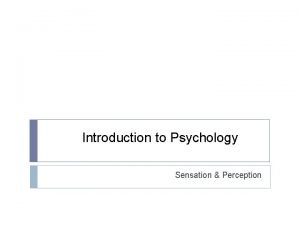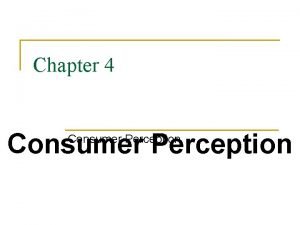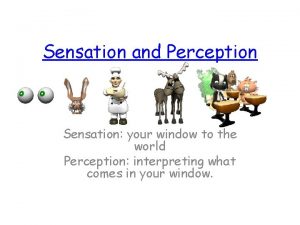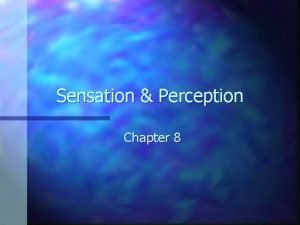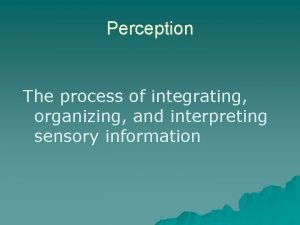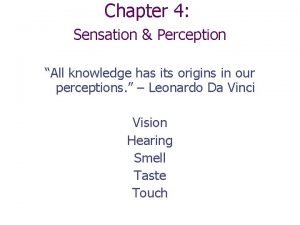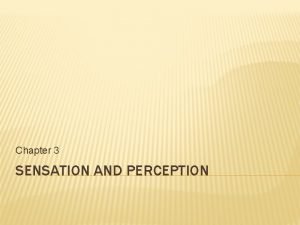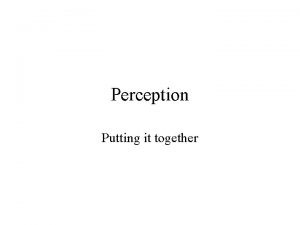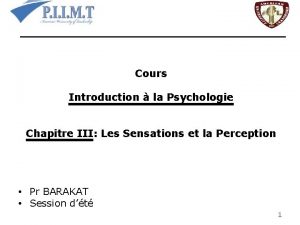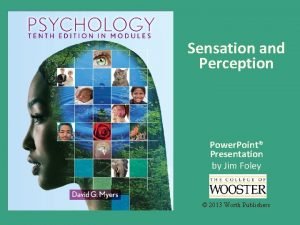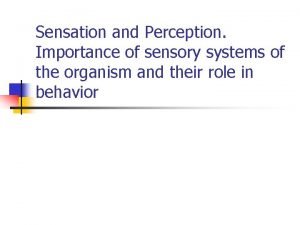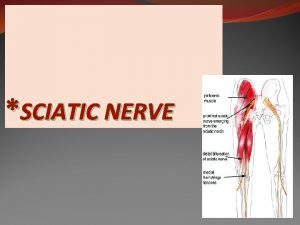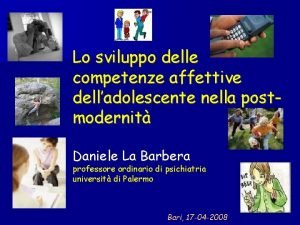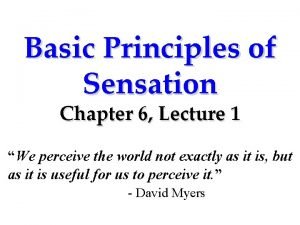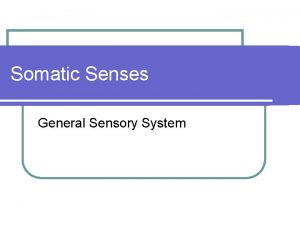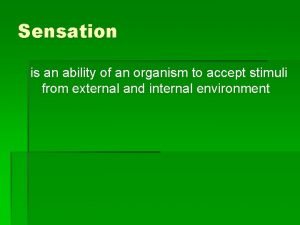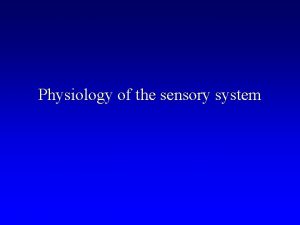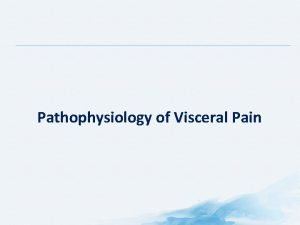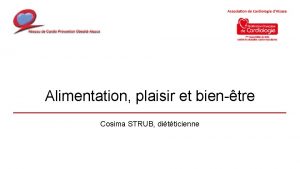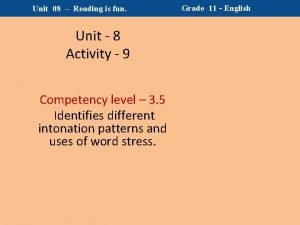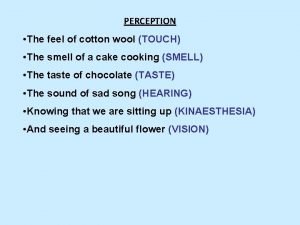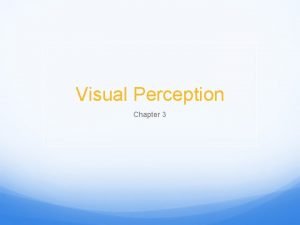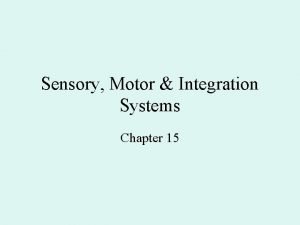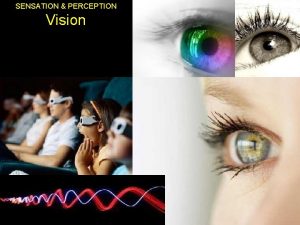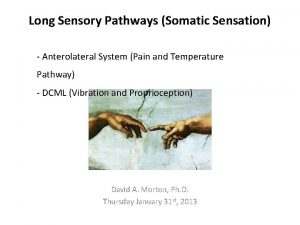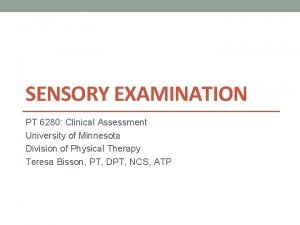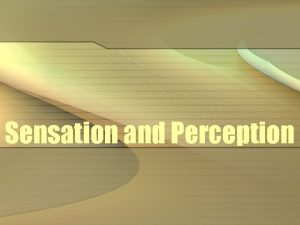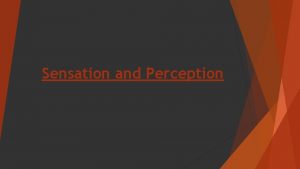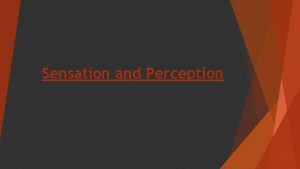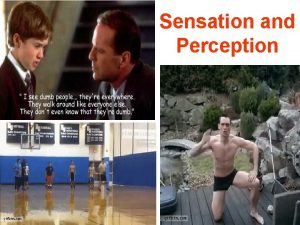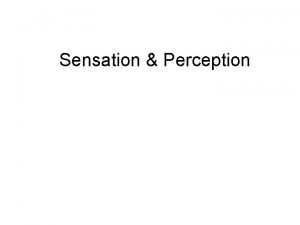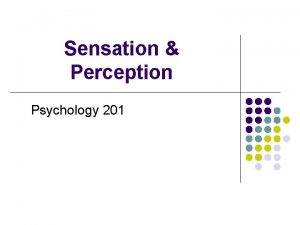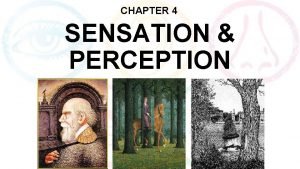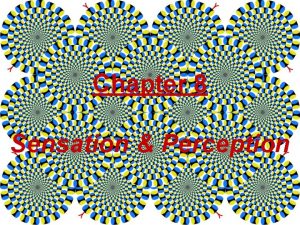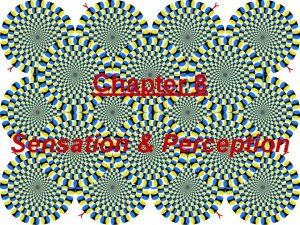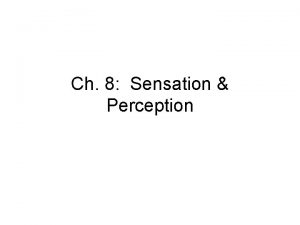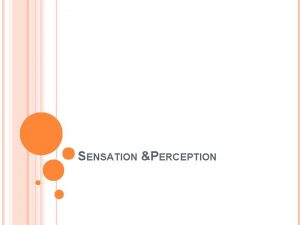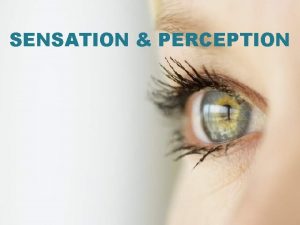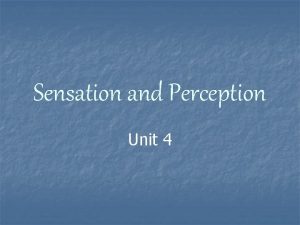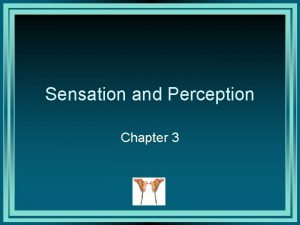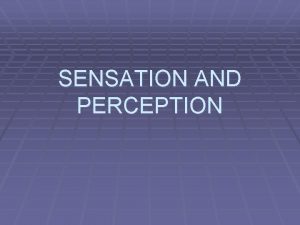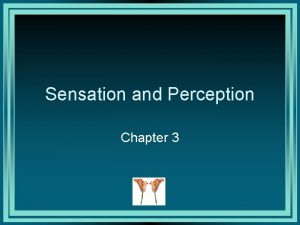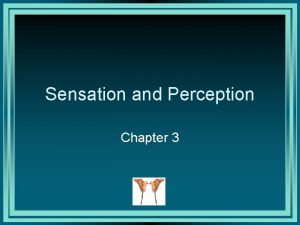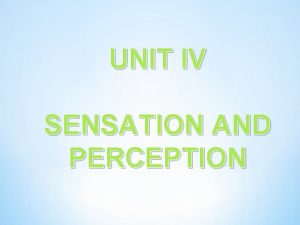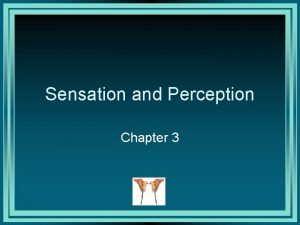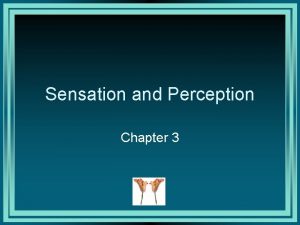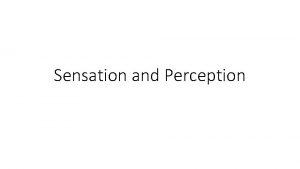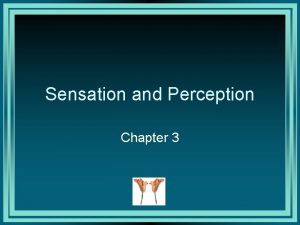Sensation and Perception Importance of sensory systems of








































- Slides: 40

Sensation and Perception. Importance of sensory systems of the organism and their role in behavior


Sensitivity training n n n The techniques employed by Kurt Lewin at the National Training Laboratories in Maine and his colleagues, collectively known as sensitivity training, were widely adopted for use in a variety of settings. Initially, they were used to train individuals in business, industry, the military, the ministry, education, and other professions. In the 1960 s and 1970 s, sensitivity training was adopted by the human potential movement, which introduced the “encounter group. ” Although encounter groups apply the basic T-group techniques, they emphasize personal growth, stressing such factors as self-expression and intense emotional experience.

Vision is the process of transforming light energy into neural impulses that can then be interpreted by the brain.


The eye composition


The rods an cones n n The retina, lining the back of the eye, consists of ten layers of cells containing photoreceptors (rods and cones) that convert the light waves to neural impulses through a photochemical reaction. Aside from the differences in shape suggested by their names, rod and cone cells contain different light-processing chemicals (photopigments), perform different functions, and are distributed differently within the retina. Cone cells, which provide color vision and enable us to distinguish details, adapt quickly to light and are most useful in adequate lighting. Rod cells, which can pick up very small amounts of light but are not color-sensitive, are best suited for situations in which lighting is minimal. Because the rod cells are active at night or in dim lighting, it is difficult to distinguish colors under these circumstances. Cones are concentrated in the fovea, an area at the center of the retina, whereas rods are found only outside this area and become more numerous the farther they are from it. Thus, it is more difficult to distinguish colors when viewing objects at the periphery of one’s visual field.


Processing the visual information n n Branches of the optic nerve cross at a junction in the brain in front of the pituitary gland underneath the frontal lobes called the optic chiasm and ascend into the brain itself. The nerve fibers extend to a part of the thalamus called the lateral geniculate nucleus (LGN), and neurons from the LGN relay their visual input to the primary visual cortex of both the left and right hemispheres of the brain, where the impulses are transformed into simple visual sensations. Objects in the left visual field are viewed only through the right brain hemisphere, and vice versa. The primary visual cortex then sends the impulses to neighboring association areas which add meaning or “associations”to them.


The field of vision n A human has a field of vision that covers almost 180°, although binocular vision is limited to the approximately 120° common to both eyes. The field extends upward about 60° and down about 75° Because the nerve fibers from the left half of the retina of the left eye go to the left side of the brain and fibers from the left half of the right eye cross the optic chiasm and go to the left side of the brain as well, all the information from the two left half-retinas ends up in the left half of the brain. And because the lens of the eye reverses the image it sees, it is information from the right half of the visual field that is going to the left visual cortex. Likewise, information from the left half of the visual field goes to the right visual cortex.

Binocular vision n Binocular depth cues are based on the simple fact that a person’s eyes are located in different places. One cue, binocular disparity, refers to the fact that different optical images are produced on the retinas of both eyes when viewing an object. By processing information about the degree of disparity between the images it receives, the brain produces the impression of a single object that has depth in addition to height and width.

Examining of eyes

Hearing n n n Hearing is the ability to perceive sound. The ear, the receptive organ for hearing, has three major parts: the outer, middle, and inner ear. The pinna or outer ear—the part of the ear attached to the head, funnels sound waves through the outer ear. The sound waves pass down the auditory canal to the middle ear, where they strike the tympanic membrane, or eardrum, causing it to vibrate. These vibrations are picked up by three small bones (ossicles) in the middle ear named for their shapes: the malleus (hammer), incus (anvil), and stapes (stirrup). The stirrup is attached to a thin membrane called the oval window, which is much smaller than the eardrum and consequently receives more pressure.



Hearing n n As the oval window vibrates from the increased pressure, the fluid in the coiled, tubular cochlea (inner ear) begins to vibrate the membrane of the cochlea (basilar membrane) which, in turn, bends fine, hairlike cells on its surface. These auditory receptors generate miniature electrical forces which trigger nerve impulses that then travel via the auditory nerve, first to the thalamus and then to the primary auditory cortex in the temporal lobe of the brain.

Sound perception thresholds



Ear inspection



Touch sensation n Touch is the skin sense that allows us to perceive pressure and related sensations, including temperature and pain. The sense of touch is located in the skin, which is composed of three layers: the epidermis, and hypodermis. Different types of sensory receptors, varying in size, shape, number, and distribution within the skin, are responsible for relaying information about pressure, temperature, and pain.

Sensory receptors encode various types of information about objects with which the skin comes in contact. We can tell how heavy an object is by both the firing rate of individual neurons and by the number of neurons stimulated. (Both the firing rate and the number of neurons are higher with a heavier object. ) Changes in the firing rate of neurons tell us whether an object is stationary or vibrating, and the spatial organization of the neurons gives us information about its location.

Pain n Pain is physical suffering resulting from some sort of injury or disease, experienced through the central nervous system. Pain is a complex phenomenon that scientists are still struggling to understand. Its purpose is to alert the body of damage or danger to its system, yet scientists do not fully understand the level and intensity of pain sometimes experienced by people. Long-lasting, severe pain does not serve the same purpose as acute pain, which triggers an immediate physical response. Pain that persists without diminishing over long periods of time is known as chronic pain. It is estimated that almost one-third of all Americans suffer from some form of chronic pain.


Spreading of pain information in the body n n Pain signals travel through the body along billions of special nerve cells reserved specifically for transmitting pain messages. These cells are known as nociceptors. The chemical neurotransmitters carrying the message include prostaglandins, bradykinin— the most painful substance known to humans —and a chemical known as P, which stands for pain. Prostaglandins are manufactured from fatty acids in nearly every tissue in the body. Analgesic pain relievers, such as aspirin and ibuprofen, work by inhibiting prostaglandin production.


Spreading of pain information in the body n n n As they travel, the pain messages are sorted according to severity. Recent research has discovered that the body has two distinct pathways for transmitting pain messages. The epicritic system is used to transmit messages of sudden, intense pain, such as that caused by cuts or burns. The neurons that transmit such messages are called A fibers, and they are built to transmit messages quickly. The protopathic system is used to transmit less severe messages of pain, such as the kind one might experience from over-strenuous exercise. The C fibers of the protopathic system do not send messages as quickly as A fibers.


The smell and the taste n n Olfaction is one of the two chemical senses: smell and taste. Both arise from interaction between chemical and receptor cells. In olfaction, the chemical is volatile, or airborne. Breathed in through the nostrils or taken in via the throat by chewing and swallowing, it passes through either the nose or an opening in the palate at the back of the mouth, and moves toward receptor cells located in the lining of the nasal passage. As the chemical moves past the receptor cells, part of it is absorbed into the uppermost surface of the nasal passages called the olfactory epithelium, located at the top of the nasal cavity.


The smell and the taste n n When a person eats, chemical stimuli taken in through chewing and swallowing pass through an opening in the palate at the back of the mouth and move toward receptor cells located at the top of the nasal cavity, where they are converted to olfactory nerve impulses that travel to the brain, just as the impulses from olfactory stimuli taken in through the nose. The olfactory and gustatory pathways are known to converge in various parts of the brain, although it is not known exactly how the two systems work together.


Sensory deprivation n Sensory deprivation experiments of the 1950 s have shown that human beings need environmental timulation to function normally. In a classic early experiment, college students lay on a cot in a small, empty cubicle nearly 24 hours a day, leaving only to eat and use the bathroom. They wore translucent goggles that let in light but prevented them from seeing any shapes or patterns, and they were fitted with cotton gloves and cardboard cuffs to restrict the sense of touch. The continuous hum of an air conditioner and U-shaped pillows placed around their heads blocked out auditory stimulation.

Sensory deprivation n Initially, the subjects slept, but eventually they became bored, restless, and moody. They became disoriented and had difficulty concentrating, and their performance on problem-solving tests progressively deteriorated the longer they were isolated in the cubicle. Some experienced auditory or visual hallucinations. Although they were paid a generous sum for each day they participated in the experiment, most subjects refused to continue past the second or third day. After they left the isolation chamber, the perceptions of many were temporarily distorted, and their brain-wave patterns, which had slowed down during the experiment, took several hours to return to normal.

Sensory deprivation n The deterioration in both physical and psychological functioning that occurs with sensory deprivation has been linked to the need of human beings for an optimal level of arousal. Too much or too little arousal can produce stress and impair a person’s mental and physical abilities. Thus, appropriate degrees of sensory deprivation may actually have a therapeutic effect when arousal levels are too high. A form of sensory deprivation known as REST (restricted environmental stimulation), which consists of floating for several hours in a dark, soundproof tank of water heated to body temperature, has been used to treat drug and smoking addictions, lower back pain, and other conditions associated with excessive stress.

Summary of senses inspection
 Chapter 5 sensation and perception
Chapter 5 sensation and perception Gestalt principles of sensation and perception
Gestalt principles of sensation and perception Relative height ap psychology
Relative height ap psychology Perception vs sensation
Perception vs sensation Sensation and perception crossword review
Sensation and perception crossword review Chapter 3 sensation and perception
Chapter 3 sensation and perception Sensation and perception
Sensation and perception Chapter 6 sensation and perception
Chapter 6 sensation and perception Psychology chapter 4 sensation and perception
Psychology chapter 4 sensation and perception Consumer perception definition
Consumer perception definition Sensation and perception
Sensation and perception Sensation and perception
Sensation and perception Vestibular sense vs kinesthesis
Vestibular sense vs kinesthesis Sensation perception
Sensation perception Sensation and perception uu
Sensation and perception uu Chapter 4 sensation and perception
Chapter 4 sensation and perception What is sensation
What is sensation Perception vs sensation
Perception vs sensation Exposé sur la sensation en psychologie
Exposé sur la sensation en psychologie Perception vs sensation
Perception vs sensation Face recognition
Face recognition Sensory systems
Sensory systems Sensation seeking
Sensation seeking Sciatic nerve sensory distribution
Sciatic nerve sensory distribution Sensation seeking significato
Sensation seeking significato Principles of sensation
Principles of sensation Types of sensation
Types of sensation Sensation
Sensation Cortical sensation
Cortical sensation Viscerosomatic levels
Viscerosomatic levels Ditticienne base sur coute sensation
Ditticienne base sur coute sensation Ditticienne base sur coute sensation
Ditticienne base sur coute sensation What causes the burning sensation in your muscles
What causes the burning sensation in your muscles Vocabulary activity 8-1 sensation answer key
Vocabulary activity 8-1 sensation answer key The touch the feel of cotton
The touch the feel of cotton Sensation
Sensation Sensation
Sensation Colour design: theories and applications
Colour design: theories and applications Dcml sensation
Dcml sensation Sensing intuition feeling thinking
Sensing intuition feeling thinking Combined cortical sensation
Combined cortical sensation






